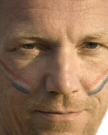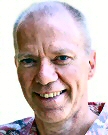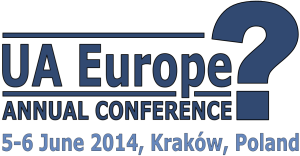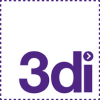Conference overview

UA Europe 2014 took place in the wonderful city of Kraków, Poland,
on June 5th - 6th, 2014 and was attended by delegates from 20 different countries throughout the world. The conference featured a series of presentations on the first day that focused on user assistance on mobile devices.
Conference topics included:
Responsive web design in user assistance * Practical HTML5/CSS3 for real writers * Maximising the effect of progressive disclosure * Trends in mobile user assistance * Automating and managing multiple projects in a multilingual environment * Embedded Help * Getting to know users * Tool support for creating mobile user assistance * XSL-T * Agile documentation in practice * Semantic search in technical content * A technical writer's role in redesigning the application UI * Rethinking documentation with DITA * Topic length and granularity * Designing user assistance for mobile business apps
UA Europe 2014 Speaker Index
![]()
Dr Chris Atherton (Equal Experts)

Chris Atherton is a senior user experience specialist at Equal Experts, where she currently works in an agile team on a GOV.UK project. Chris's portfolio includes stints at Skype and the BBC, as well as agency work in retail, healthcare and not-for-profit sectors. Her three favourite projects to date are: (1) redesigning the visas and immigration experience for gov.uk; (2) researching and creating a digital strategy to help young people talk about mental health; (3) storyboarding and scripting a children's animation about thyroid disorders entirely in rhyme. Before running off to join the software circus, Chris researched and taught psychology; she has a PhD in cognitive neuroscience, and spends a lot of time thinking about people's attention — namely how to get it, and how to keep it. Chris tweets at @finiteattention.
Session topics
Thomas Bro-Rasmussen (GN Otometrics)

Based in Denmark, Thomas is currently Localization Manager at GN Otometrics. He has more than 20 years of experience as a consultant on assignments relating to user assistance and single sourcing. His expertise covers a wide-ranging portfolio of tools, including products from Corel, Adobe, Madcap Software, Quadralay, and others. He is highly experienced in dealing with the "loose ends" that are needed to comply to a successful production environment, where deadlines have to be met and quality has to be maintained. Thomas has an M.Sc in Science and Human Physiology, but has devoted his working career to help people with their "computer problems".
Session topic
Matthew Ellison (UA Europe)

Matthew has over 25 years of experience as a user assistance professional in the software industry. Much of this time was spent managing a team of writers and trainers at a UK-based consultancy company, before enjoying a period in the US as Director of the WritersUA Conference.
Matthew has been a highly rated and respected speaker at conferences and training events throughout the world since 1997, and has covered a diverse range of topics from context-sensitive Help, to the Spice Girls! He now runs UA Europe, an independent UK-based training and consulting company that specialises in user assistance design and technology.
Matthew holds a B.Sc. in Electronic Engineering and a Post-Graduate Certificate of Education from Bristol University in the UK. In 2009 he was the winner of the prestigious Horace Hockley award that is presented annually by the Institute of Scientific and Technical Communicators (ISTC). In addition to his various consulting assignments for UA Europe, Matthew has been a visiting lecturer on the MA Technical Communication course at Portsmouth University. He also a certified instructor for Captivate, Flare, Help & Manual, and RoboHelp.
Session topics
Ray Gallon (Culturecom)

Ray is the owner of Culturecom, a consultancy in Business Process Improvement through Communication, and co-founder of The Transformation Society research group, with over 20 years' experience in the technical content industries.
Ray is a director of the Society for Technical Communication (STC) and past president of STC France. He is a two-time winner of awards in the trans-European technical communication competition, including Best in Show.
He is a frequent speaker at conferences, webinars and seminars around the world, is a published author, and has taught in universities throughout the world. He shares his life between Barcelona, Spain, and the Languedoc region of France.
Session topic
Dave Gash (HyperTrain)

Dave is the owner of HyperTrain, a Southern California firm specializing in technology consulting and training for hypertext developers, with an all-new web site at www.davegash.com. A veteran software professional with over thirty years of development, documentation, and training experience, Dave holds degrees in Business and Computer Science, and is well known in the tech pubs community as an interesting and engaging technical instructor. Dave is a frequent speaker at User Assistance conferences in the US and around the world.
Session topics
Jang F.M. Graat (JANG Communication)

Jang studied Physics, Philosophy and Psychology. He has worked in technical communication for more than 25 years and in a wide variety of industries. As a presenter and trainer, he has travelled around the globe many times. Since 1995, Jang has run his own company as a consultant and programmer of user-friendly DITA and DITA-inspired solutions. He is based in Amsterdam, Netherlands.
Session topics
Pawel Kowaluk (Motorola Solutions)

Pawel is a technical communication tools specialist, DITA evangelist, programming ninja, and co-founder of soap! technical communication community (http://soapconf.com/).
Session topic
Rajesh Khurana (Ericsson India Global Services)

With more than nine years' experience in technical communication, Rajesh specialises in Information Mapping, Training and Mentoring, and Usability Analysis. He is IMP certified (2012 to 2015) and is an active STC member. Rajesh has written and presented a paper on Agile documentation at Ericsson Global.
Session topic
Karen Mardahl (SimCorp)

Karen Mardahl writes documentation for financial investment software in Copenhagen, Denmark. Her job is 9-to-5, but geek that she is, she can see technical communication in pretty much all aspects of our lives all day long. She tweets at @kmdk and @stcaccess and occasionally graces mardahl.dk with a blog post.
Session topics
Ulrike Parson (parson AG)

Ulrike is the CEO of parson AG, which is based in Hamburg, Germany. She looks back on almost 20 years of professional experience in technical writing. She is specialized in writing documentation for software engineers, agile project management, and consulting for knowledge management and XML-based authoring. The clients of parson include international and regional companies from various branches, such as software development, semiconductors, logistics, education, and healthcare.
Session topics
Dr Tony Self (HyperWrite)

Based in Melbourne, Australia, Dr Tony Self has over 30 years of experience as a technical communicator. For over 20 years, Tony has worked in the areas of online help systems, computer-based training, and electronic documents.
In 1993, he founded HyperWrite, a company providing training and consultancy in structured authoring, Help systems, DITA, and technology strategy. Tony completed his PhD in semantic mark-up languages in 2011, and his book The DITA Style Guide was published in the same year. He is the Director of Training for TCTrainNet, and is an adjunct teaching fellow at Swinburne University. Tony is a member of the OASIS DITA Technical Committee (and chair of the DITA Help Subcommittee).
Session topics
Rajeev Kumar Tiwari (Ericsson India Global Services)

With more than three years of experience in technical communication, Rajeev is IMP certified (2012 to 2015) and specialises in Information Mapping. He loves to explore new and innovative tools that could be of help to the technical writing community, and has presented a paper at STC City Chapter and STC Regional Conferences.
Session topic
Agnieszka Tkaczyk (IBM)

Agnieszka is an Information Developer at IBM and a freelance translator. She holds a Bachelor's degree in English teaching and a Master's degree in Polish-English translation. In her everyday work she strives to provide high-quality product documentation and video tutorials that meet the customers' expectations. She believes that good relations with the extended team and a friendly working atmosphere are more likely to contribute to the quality of user documentation than corporate processes. Agnieszka is also interested in user experience and user interface design.
Session topics
Willam van Weelden (WvanWeelden Consultancy)

Willam van Weelden is a technical writer and functional designer from the Netherlands. Willam is an Adobe Community Professional, ranking him among the world's leading experts on RoboHelp. Willam's specialities are HTML5 and RoboHelp automation. Apart from RoboHelp, Willam also has extensive experience with other industry standard programs such as Adobe Captivate and FrameMaker.
Session topic
Joe Welinske (WritersUA)

Joe Welinske specializes in helping your software development effort through crafted communication. The best user experience features quality words and images in the user interface. The UX of a robust product is also enhanced through comprehensive user assistance. This includes Help, wizards, FAQs, videos and much more. For over twenty-five years, Joe has been providing training, contracting, and consulting services for the software industry.
Joe published the book Developing User Assistance for Mobile Apps. He also teaches courses for Bellevue College, the University of California, and the University of Washington.
Session topics
UA Europe 2014 Session Index
On day 1 of the conference, one of the two optional session tracks focused on Mobile User Assistance.
Jump to list of sessions in Mobile User Assistance track.
List of general sessions
- Practical HTML5/CSS3 for real writers (Dave Gash)
- A technical writer's role in redesigning the application UI (Agnieszka Tkaczyk)
- Agile documentation in practice (Ulrike Parson)
- From user assistance to user guidance (Jang F.M. Graat)
- Getting to know users (Dr Chris Atherton)
- A dive into the quantum funnel (Ray Gallon)
- Embedded Help: nuts and bolts (Dave Gash)
- Automating and managing multiple projects in a multilingual environment
(Thomas Bro-Rasmussen) - Semantic search in technical content (Pawel Kowaluk)
- Designing transactions successfully (Dr Chris Atherton)
- Opening the innovation door: rethinking documentation with DITA (Dr Tony Self)
- Getting things done for today's technical communicator (Karen Mardahl)
- How long is a topic? (Matthew Ellison)
- Maximising the effect of progressive disclosure (Jang F.M. Graat)
- The vibe of XSL-T (Dr Tony Self)
- A case study of enhanced user assistance in the GUI
(Rajesh Khurana and Rajeev Kumar Tiwari) - Who are we? A mirror for UA professionals (Joe Welinske)
List of sessions in Mobile User Assistance track
- Responsive web design in user assistance (Dr Tony Self)
- Tool support for creating mobile user assistance (Matthew Ellison)
- Trends in mobile user assistance (Joe Welinske)
- Designing user assistance for mobile business apps (Willam van Weelden)
![]()
General sessions
Practical HTML5/CSS3 for real writers
These days you can't move your mouse without hitting a list of "must-use" HTML5/CSS3 features. The problem is, many new features — and their descriptions — are highly technical, intended for audio engineers, video producers, graphics artists, game designers, and other code jockeys. Don't these new technologies have any features that benefit regular, everyday writers? Why, yes they do, and we have them! In this session, we'll explore a selected set of semantic HTML5 tags and related CSS3 features that are actually relevant to real-world technical writers, examine some practical uses for them, and see them in action as we migrate a page from HTML4/CSS2 to HTML5/CSS3.
Delegates learned:
- How semantic structural tags differ from standard linear tags
- Which HTML5 elements and CSS3 features best apply to regular content
- How and where to use them in web pages and user assistance
- How to apply styles to sets of tags for consistent results
A technical writer's role in redesigning the application UI
We all know how important the first impression is. When we go to a job interview, we pay special attention to our outfit and good manners to be perceived as professionals. The same principle applies to software. And since the user interface is the first thing our customers will have experience with, special attention should be paid to its look and feel as well as usability. Although this seems to be a common-sense approach, after all we want our customers to be satisfied with our product, it frequently happens that the UI is treated a low-priority issue. The presentation is a case study of how the UI of a product that was initially developed only by software engineers changed after UX designers and technical writers stepped in.
Delegates learned:
- How to incorporate user assistance if the help mechanism is not implemented
- How the lack of a built-in help mechanism influences the quality of user assistance and the application interface
- Why and how to avoid extremities in implementing user assistance
- What are dos and don'ts of implementing user assistance based on retrospections
Agile documentation in practice
The agile manifesto and the Scrum methodology do not offer specific solutions regarding technical documentation. Communication and team collaboration are valued much higher than writing documentation. But what does this mean for the technical writers? For a start, there won't be a detailed specification that they can work from. Instead, the backlog and everything they hear and see during team meetings will be important information sources. Well-written user stories are a great resource, because they describe the software from the user's point of view.
Each sprint is supposed to have a potentially shippable product increment as a result. If user manuals are part of the deal, you need a very flexible, modular, and automatable authoring environment. Also, finding the right time schedule for your authoring efforts is one of the biggest challenges.
The presentation will provide some general guidelines and recommendations about dealing with common problems and pitfalls in agile environments, as well as present the benefits of working in such an environment.
Delegates learned:
- Agile principles (Scrum) that affect technical documentation (communication/cooperation, verification, transparency, responsibility)
- About the challenges and pitfalls that technical writers have to face
- The technical writer and the agile team: symbiosis or service?
- Tool and infrastructure recommendations
From user assistance to user guidance
Jang F.M. Graat (JANG Communication)
Various companies are launching innovative products building on interactivity and the availability of affordable tablets, creating user guidance that minimize the user's learning curve by taking the user through the procedure step by step, reacting on entered data by branching to other procedures/substeps where applicable. Data is automatically fed back to the server and can be used to measure performance, optimise procedures and have realistic estimates about the time required. This puts technical documentation at the heart of business intelligence. Application areas that come to mind are field maintenance tasks but also door-to-door surveys. The presentation shows the concepts behind this technology and showcases one application.
Delegates learned:
- How to use tablets to guide users through procedures
- How to automatically gather feedback and performance data
- How to create documentation, help and user guidance from the same DITA source
Getting to know users
Chris Atherton (Equal Experts)
Testing your product or service with just one user will surprise you. Testing it with a handful of users may radically alter your perspective on the thing you're building. Regular usability testing can change forever the way your organisation thinks about the design-and-build cycle.
Regardless of where you work, your organisation can always benefit from listening more to the people who use the things you make. Users are all different and want different things — but that doesn't mean you can't draw some useful general conclusions. Talking to users about their experiences with your product is one of the most valuable investments a company can make, and it doesn't have to be labour-intensive or costly: in this talk, Chris will discuss easy, low-friction ways of getting started, and the benefits for you and your organisation of engaging with the user base.
Delegates learned:
- How to conduct usability testing on a shoestring (and then how to scale it up)
- How to feed back the results of usability testing in ways that have the most impact
- The ways your business can benefit from getting to know users, including reducing costs and risk
- How conducting regular usability testing can benefit you personally, by improving your mood and motivation
A dive into the quantum funnel
The web lets us quickly find morsels of information to satisfy our immediate needs, but we get this information out of sequence, without the context to understand it. We all have "quantum black holes" in our knowledge bases, which we fill in using a variety of strategies, mostly improvised. In this interactive session, we will work together on a cognitive model and methodology to help us design information for this world of standalone chunks that comes from a new user interaction model, and a new type of user/learner.
Delegates learned:
- Basics of how the hypertextual environment has changed learning
- Learning principles that underpin the techniques we need to use
- Techniques to help develop User Assistance content that facilitates finding the information the user needs
- How to use structured authoring to accomplish this
Embedded Help: nuts and bolts
Embedded help is the "next big thing" in user assistance, and with good reason. It's accessible, unobtrusive, and serves both the "just enough" and "progressive disclosure" philosophies. Conceptual overviews and design analyses abound, but practical, how-to tutorials have been scarce — until now. This session explores two types of embedded help source content, in HTML and XML, and shows you exactly how to prepare the source text, locate and retrieve it from either format, insert it into the web application screen, and make it match the app's look and feel. Live, working (we hope!) demos illustrate the two techniques, and all code used is freely available from the presenter.
Delegates learned:
- How to prepare embedded help content using HTML and XML source
- How to read embedded help from the server and insert it into the web app
- How to establish an embedded help area in the app and style the help content
- How to retrieve embedded help content for different screen objects
Automating and managing multiple projects in a multilingual environment
Thomas Bro-Rasmussen (GN Otometrics)
One step up from technical writing, or rather one step further. This presentation takes you through workflows and methods that has enhanced a normal day-to-day technical writing life by automating all processes that could be automated, leaving more time to the actual writing process. Hence a higher quality of content, more manuals within the same time frame as previous, a considerable reduction cost in translation and far fewer errors. This customer case presentation is a demonstration of how MadCap Flare can be used "outside of the box", yet maintaining the core and purpose of the product. In other words: it's back to basics, exploiting the future.
Semantic search in technical content
Pawel Kowaluk (Motorola Solutions)
Semantic search is about machines predicting our needs and answering questions we did not know we would ever ask. The challenge we faced at Motorola was to create an automated mechanism for generating ontology trees and semantic graphs to enable advanced semantic search capabilities in DITA-source technical content. Open-source tools are available to achieve such results. By giving examples, this presentation will illustrate the importance of semantic search capabilities and benefits for the organisation as well as the customer. Key thought: let the system answer questions you did not foresee the user would ask.
Delegates learned:
- What semantic search is
- How Google implements the principle
- How you can use Google Semantic Search to your advantage
- How a semantic search solution can be built using open-source technology (demonstrated by a real-life example)
Designing transactions successfully
Dr Chris Atherton (Equal Experts)
If you want people to read and understand your web content, less is definitely more. In this session, Chris will talk about her UX design work for the UK Home Office's Visa and Immigration service. Part of the recent GOV.UK overhaul, the web-based visa service has to be easy for anyone to use — including those whose first language isn't English, who have never applied for a visa before, or who aren't confident using computers.
The GOV.UK design style has drawn both praise, for being highly accessible, and criticism, for being ugly and "un-designed"; Chris will discuss the virtues and challenges of applying an ostensibly simple design to online transactions. In the words of Albert Einstein, "everything should be made as simple as possible, but no simpler".
Delegates learned:
- How to improve readability and usability by minimising content on the page
- How visible navigation helps frame users' understanding of what’s happening, as well as where they are
- How to help users recover from predictable "but this doesn’t apply to me" situations
- How to reduce your organisation's support costs by listening to what the business already knows
Opening the innovation door: rethinking documentation with DITA
When documentation is migrated from legacy to DITA, work practices are also changed from the conventional processes of authoring, editing, translating, and publishing. However, many benefits of moving to DITA are not being realised because we are upgrading legacy processes, rather than rethinking them completely.
With less than 10 minutes of effort, a report can be generated, for example, listing all of a document's links to external Web sites. This allows the extract to be checked for dead links, rather than the entire document. Extrapolate this to other elements in the document, and the opportunity to completely change the editing and QA process becomes apparent. DITA content can be sorted, filtered, re-sequenced, and otherwise processed in ways not possible previously. DITA content can be dynamically rendered and delivered to suit an individual reader's preferences.
In this presentation, Tony Self demonstrates a range of ideas that show how DITA can open the door to innovation at all stages in the documentation processes.
Delegates learned:
- How conventional processes can be approached differently in a DITA workflow
- How processes can be re-thought, rather than migrated
- The types of automation that can be achieved
- What skills and resources are needed for "document engineering"
Getting things done for today's technical communicator
How can we do everything smarter and more efficiently with minimal nerve-frazzling and brow-sweating? This presentation is about managing your time in a world where we are asked to achieve more and more with fewer and fewer resources, regardless of industry, authoring tool, experience, or team size. For years, I thought I managed my time just fine thank you very much. Then I got a new job. Everything was new - domain, software, team. I was delivering on time, but behind the scenes, my frustration was growing until I realised that I was simply not managing my time very well. Greatly inspired by my closest colleague and discussions of David Allen's Getting Things Done, I'm getting my time management mojo back. I'll present my experience and ideas with you, followed by an open discussion with the audience.
Delegates learned:
- What are the crucial points of getting things done that a technical communicator should know
- Who is responsible for getting things done
- What methods (and tools) can help you get things done
How long is a topic?
How long should a user assistance topic be? This question has been debated over the past twenty years and more, with popular trends ranging from Microsoft's minimalist approach of the late 1990s to the more extended articles that are more prevalent today. The issue of topic length and granularity of content has a critical impact not only on the usability and effectiveness of our user assistance, but also on the potential for single-sourcing and re-use. So how granular should our topic content be? Is there an ideal length from a user's viewpoint, or does it depend on the experience-level of the user, the delivery method of the user assistance, the nature of the content, and other factors? And how should single-sourcing considerations affect our decisions? This session considers these questions and the opposing arguments of the topic-length debate.
Delegates learned:
- A brief summary of the research that has informed decisions on topic length over the past 20 years
- The advantages and disadvantages of short and long topics
- How user behaviour and success is influenced by topic length
- How topic length can impact on the potential for re-use
- Techniques for enabling longer topics work better for users
Maximising the effect of progressive disclosure
Jang F.M. Graat (JANG Communication)
Progressive disclosure is a relatively new paradigm in user assistance and one that may take a lot of time to implement. Based on minimalism in technical documentation, the core idea is to let the users decide where and when they need more information. There are various techniques and methods to implement progressive disclosure, which require more or less time depending on their level of sophistication. But without understanding how the user thinks, none of these techniques and methods will become truly effective. Poorly designed progressive disclosure may take the users on wild goose chases that may leave many of them in utter confusion, which of course reflects back on your information product. This presentation showcases good and bad examples of progressive disclosure and explains some of the basic psychological principles to follow when designing yours.
Delegates learned:
- The basic ideas behind progressive disclosure
- The effects of various progressive disclosure techniques
- About good and bad examples (and how to tell them apart)
The vibe of XSL-T
The S in the term XSL-T is confusing, because it stands for Stylesheet. But XSL-T is nothing like CSS, and is not much at all to do with what technical authors would call stylesheets. In this presentation, Tony Self explains what XSL-T is, and how it is a powerful tool within the technical communication process. While technical authors should not necessarily attempt to learn XSL-T, they should be very familiar with what it is capable of... the "vibe" of it. XSL-T enables "document engineering", which many argue is the future of Help systems, technical communication, and documentation more broadly.
Delegates learned:
- Where XSL-T fits in the XML universe
- The difference between XSL-T and the two other XSLs
- What sort of things XSL-T can be used for
- What level of expertise is needed to work with XSL-T
A case study of enhanced user assistance in the GUI
Rajesh Khurana and Rajeev Kumar Tiwari (Ericsson India Global Services)
Based on the feedback from one of the customers, a need was felt to improvise our current user assistance within our product GUI. The customer can access the product information and help as online help and context sensitive help. The need was felt to explore a new way of presenting more personalised and engaging user assistance that will make our customer even happier. After a series of discussions and investigations, we came up with a solution: personalised and video-based context sensitive help. This presentation explains what we finally achieved to fulfil the requirement.
Delegates learned:
- How to enhance user assistance within the GUI
- How user assistance can be customised for specific user roles
- New ways to access the context sensitive help
- About platform independent help
- How we created a video-based help system that can be accessed using almost any device: desktop, web, and mobile
Who are we? A mirror for UA professionals
Find out what interests and challenges you share with your UA peers. Joe is going to summarize many of the details from the 2014 WritersUA Surveys on Skills, Technologies, Tools, and Salaries.
Sessions in Mobile User Assistance track
Designing user assistance for mobile business apps
Willam van Weelden (WvanWeelden Consultancy)
Mobile applications have been thoroughly established for consumers and are making their way into businesses as well. We will see an explosion of apps aimed at business users, whether they work at the office or in the field. We've seen a lot of buzz about UA for consumer apps, but apps for business are a different ballgame: they are more complex, must integrate with existing security solutions and must integrate with existing applications.
This means that there are more types of users, multiple configurations, complex applications and multiple delivery channels. Find out why it is OK to supply a 30-page manual with your app, and yet why your end-users should never see a manual. Join Willam in a session on how to support business apps and the forgotten users of your apps.
Delegates learned:
- Why apps for business are a whole different ballgame than the mobile apps everyone knows
- Why your business app should and shouldn't have a 30-page manual
- Why UA is an integral part of the User Experience design
- How to eliminate help for end-users with embedded UA
Responsive web design in user assistance
In the past few years, the pace of change in reading device technology has been breathtaking, and approaches that many of us are currently using are losing currency. We can no longer make any assumptions about how our content might look, or what screen it might be displayed on. It may be displayed on a desktop device with two widescreens, it may be displayed on a smart phone, or it may be projected onto a head-up display (HUD). One assumption we can make in the short term is that our content will be less likely to be displayed on a conventional computer screen.
The idea of adaptive content, where different information is presented on different devices, is now generally seen as a flawed approach, as it is based on the misconception that people have different information needs when using mobile devices. Instead, Responsive Web Design with a Mobile First philosophy is emerging as a more appropriate response to the challenges.
This session introduces Responsive Web Design techniques, and explains how HTML5 and CSS3 are fundamental to the approach. We will then look at the Mobile First strategy, and see how this practically informs information design decisions. The ways in which these approaches can be introduced into user assistance workflows are finally discussed.
Delegates learned:
- How people use mobile devices at home and in the workplace
- About the difference between Adaptive Web Design and Responsive Web Design (RWD)
- The principles of Mobile First
- The role of HTML5 and CSS3 in RWD
- How RWD impacts upon user assistance design
Trends in mobile user assistance
Smartphones have sparked a huge, new software segment: the mobile app. This creates an important pair of questions for user assistance professionals: what is our role going forward in mobile, and how can we prepare to take that on? User Assistance does have a role in supporting mobile apps. As the mobile app market continues to soar, this is becoming the next frontier for user assistance professionals. This session provides an overview of current issues regarding design, writing, tools, and planning of your mobile UA.
Tool support for creating mobile user assistance
Surveys show that end-users are increasingly using mobile devices such as phones and tablets to consume the user assistance content that we produce. This means that we have to adapt radically the format, design and overall approach of our user assistance — the tri-pane-based model that has served us well for the past 18 years is no longer appropriate for these smaller screens. But what support do today's authoring tools and technologies provide for a new design model that will enable us to publish for a range of different screen sizes? This session looks at how a number of different authoring tools including Adobe RoboHelp, MadCap Flare, WebWorks ePublisher, and ComponentOne Doc-To-Help address this issue. We'll also look at the options that you have for publishing mobile user assistance from DITA.
Delegates learned:
- What responsive design and adaptive design mean, and why they are important
- How each of the major Help Authoring Tools supports mobile user assistance
- The strengths and weaknesses of each of the different approaches
- How you can create mobile user assistance from DITA
Exhibition and Vendor Presentations at
UA Europe 2014
![]()
Exhibiting companies
Click a logo to view that company's web site.
Presentations by sponsors and exhibitors
The first day of main conference concluded with a series of presentations by sponsors and exhibitors.
The presentations were as follows:
What’s new in Adobe RoboHelp 11
(Vikram Verma, Adobe)
In this presentation, Vikram Verma showcased some of the exciting new features in the latest release of RoboHelp 11. He demonstrated how you can ride on the mobile publishing trend using the new single click Responsive HTML5 publishing feature, which also allows you to quickly customize the HTML5 layout using the wizard-based layout editor. Delegates also learned about the new ways of achieving effective collaboration and single sourcing using the new cloud integration and topic sharing features of RoboHelp 11. In addition, there were several LIVE product demos on new features such as branding your printed documentation with custom headers and footers.
Introduction to the MadCap Software Suite of Tools, Including MadCap Flare
(Mike Hamilton, MadCap Software)
This presentation met the needs of those who might be new to the MadCap tools, but also included new information for those already familiar with tools like MadCap Flare. Mike started with an overview and workflow demo for the MadCap Flare product. After the overview demo, Mike then focused on the new capabilities and functionality of the new Flare version 10 released recently.
When the going gets tough —
tackling high-end requirements in software documentation
(Christoph Kaemena, SCHEMA GmbH)
Ever hit the barriers of help authoring tools? Did you wonder whether a real CCMS (component content management system) might be a better solution for some scenarios? Is CCMS just another way for saying DITA? Delegates joined Christoph Kaemena from SCHEMA for an overview of SCHEMA ST4, the easy-to-deploy CCMS used for online help by many world-leading companies across a range of sectors.
From static books to dynamic semantic publishing
(Bruno Fraissinede, Antidot)
While authoring solutions have greatly evolved over the last five years, their publishing counterparts are still stuck in a static "flat and fat" HTML or PDF based document generation model delivering a poor user experience. After having gone through the analysis of what is wrong with publishing technical documentation today, delegates saw how to switch from a print-oriented view to a new topics- web- and user-centric approach.









